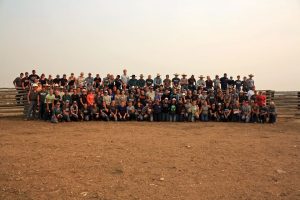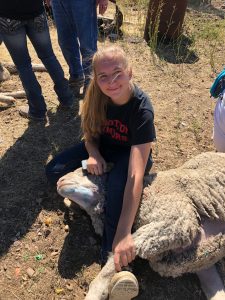Semesterly “Sheep Day” provides hands-on experience for students
This is a Student Submission from Samantha Clark.
Samantha Maye Clark is a sophomore here at Utah State majoring in Animal Science. She grew up in a Maryland suburb not far from Washington DC. Samantha has had a love for animals her whole life, and decided that she wanted to become a vet at the age of 5. She’s been working her way towards that goal ever since. When she is not working with animals, Samantha enjoys traveling and hiking, especially with her border collie mix, Bentley.
Professor Lyle “Doc” McNeal has been teaching at USU for almost 40 years; for the last 27, he has been organizing and running Sheep Day with the Broadbent family.
Once a semester, numerous Utah State students trek to the Broadbent’s ranch in Wyoming early on a Saturday morning to perform breeding soundness exams (BSEs) on hundreds of rams. The exams help identify rams with Brucella ovis, a microorganism that causes infertility. These “dud” rams can transmit B. ovis to ewes, where it can infect other males.
McNeal and the Broadbents, who own the ranch and the rams, met while McNeal was managing the largest ram sale in the country. McNeal told the Broadbent family about the benefits of BSEs, and together they developed Sheep Day. McNeal is able to teach agriculture students how to do BSEs, and the Broadbents get their rams tested and their flock improved.
 Samantha Clark
Samantha Clark Students gather for a group photo at Sheep Day.
In 2002, McNeal started working with Tami Spackman, an advisor in the Animal, Dairy and Veterinary Science department, and made Sheep Day a variable credit class. Students can now take the class and earn up to five credits.
Each Sheep Day takes months of extensive planning between McNeal and the Broadbent family. McNeal organizes all of the supplies and finds drivers for the students attending the event. McNeal also calls the McDonald’s in Evanston, Wyoming and warns them that 100-plus people will be stopping there early on the day of the event.
Once the day arrives, students travel to the ranch, unload supplies, and are divided into teams for the day. McNeal demonstrates a BSE on a ram and answers any questions the students have. Then students get to work conducting BSEs on every ram in the Broadbent’s herd.
Blood, wool and semen samples are taken from each sheep. Students examine the sperm samples under microscopes and record their analysis. If the ram is healthy, it is marked with a green line on its forehead and it placed into one pen. If a ram appears unhealthy and not suitable for breeding, McNeal reviews it and then makes the call to cull the ram. A red X is marked on its forehead and the animal is placed into the cull pen.
Once every ram has been testes, everyone packs up the supplies, takes a group picture, and loads up into the minivans and buses to head back to Logan.
Over the next few days, students at USU’s South Farm research center clean all of the instruments and put all of the supplies back where they belong. McNeal and Laurel will grade all of the wool samples using a machine called the OFDA 2000 (Optical Fiber Diameter Analysis). When the blood results come back, McNeal and students compile the final reports to tell the Broadbents which rams to cull.
This program has increased the Broadbent’s lambing rate from 104% to 120%. It’s increased revenue and improved their entire business.
However, Sheep Day has a bigger impact than just improving one ranch in Wyoming: it’s taught thousands of students. It allows ADVS students prove to themselves and others that they are meant to be in their program. It gives students valuable experience to talk to future employers about.
The first Sheep Day I went to, I worked side by side with people that will be my colleagues for the rest of my life. I found a passion for sheep that led me to take more sheep classes and go on more amazing trips to different states, learning even more about sheep. It’s a program I put on my resume, a program I’ve written college admissions essays about, and a program I encourage every student to take part in at least once.

Andrew Myers is an animal science major who feels that Sheep Day is an important learning experience. “It offers students an opportunity to further their understanding of the importance of agriculture,” Myers said. “It gives them a place to do something they might enjoy that they don’t usually get to do.”
Amber Reed, another animal science major, grew up in a more urban area, unlike many of the students who go to Sheep Day. “I didn’t really have a lot of experience with livestock. It gave me an opportunity to experience something I didn’t get to growing up,” she said.
Although Sheep Day started out as a program for agriculture students, students from all majors can come and learn.
Leslie Price, a communications major, said that Sheep Day is important “because it teaches kids there is more to raising livestock.”
Sheep Day teaches important skills to future veterinarians, farmers, professors, and consumers, and every person that participates walks away having learned something about agriculture. Sheep Day gives students an attachment to the land and agriculture. Even students who were raised in a city environment are given a way to connect to the land, making them a better student, a better citizen, and maybe sparking a love for agriculture in them.
Sheep Day for spring semester will be held on April 13th.


Very well written informative article!!!
Many students will want to have this experience as a result of your article.
Congratulations Samantha.